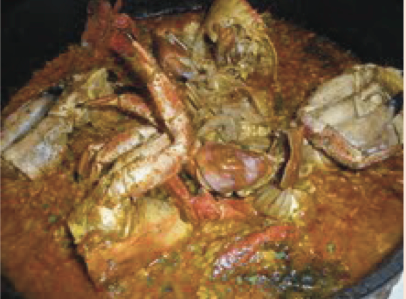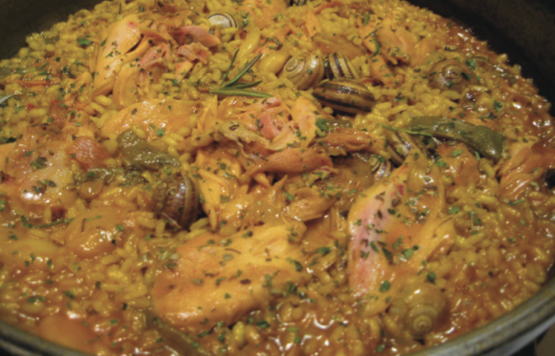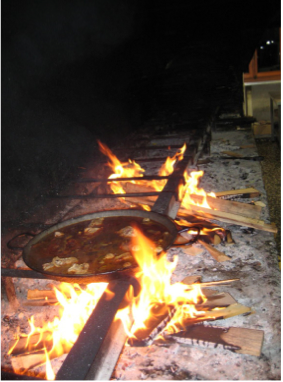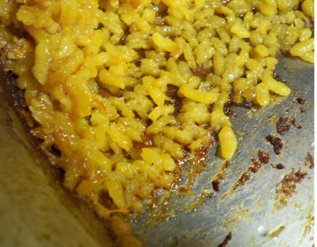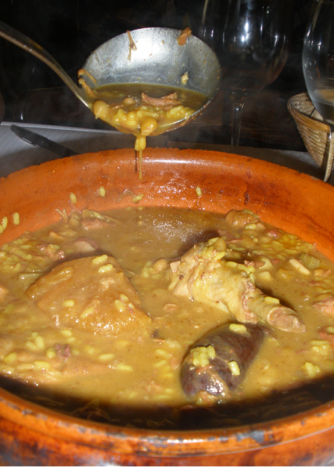
Yes, I do think of paella from Spain as something of a problem dish. For starters, we've been hearing for years that just as Italy conquered America with pizza, and just as China conquered America with wonton soup, so Spain shall conquer America soon with its iconic dish. The wonderful food of this beautiful European country will finally grow popular in America, the reports perennially say, and paella shall lead the way.
Except that... it hasn't happened! For decades. And it ain't gonna happen anytime soon! Why?
The very definition of the dish is rather fuzzy. According to traditional chefs from Valencia, the city on Spain's northeast coast that is home to paella, only one permutation of this rice specialty should be given the name of paella: rice with snails, rabbit, and two kinds of beans.
Everything else, they say, was created for tourists, starting in the 1950s, who had it in their heads that paella should include both shellfish and chorizo, the smoky Spanish sausage. But traditional paella, created in the region by medieval Arabs, never had shellfish, never had pork, and certainly never had them in tandem! Sure, today, eager-for-business restaurateurs in Spain will call anything paella -- but the foundations of the dish are rocked by such flexibility.
And that vaguely defined "mixta" is what we see in "Spanish" restaurants in the U.S.
It is often cooked and served in a pot (which creates moisture), not a wide paella pan; the rice is usually colored yellow by turmeric; the focus is indubitably on the shellfish, almost always piled high and overcooked.
How could this dish not have a reputation-damaging identity crisis? The real thing in Valencia is cooked over a wood fire...
... which gives the finished product a brownish-look, not a yellow one. The flavors of smoke are present... and, in a perfectly cooked one, the rice has a crispy, browned character to it, with a deep flavor contributed by the cooking liquid.
And that's problem #2: Real paella is not easy to cook! Many chefs in Valencia restaurants have compromised on the traditional dish. How can we ever hold out paella as Spain's "great yellow hope" in America?
This is exactly where "the other paella" comes into play. As I was working my way through the Valencia region, I noticed that soupier versions of paella existed in abundance, never called "paella," and never requiring all that intricate wood smoke and browning.
They break into two main categories: meloso, which is a little creamy; and caldoso, which is downright soupy, like the asopao of the Caribbean, always cooked in pots.
In my tasting experience -- even in Valencia! -- the soupy ones were more satisfying than the dry paellas! Even Raquel Perez of Restaurante El Tossal in downtown Valencia, one of the greatest local restaurants, offers no dry rice dishes at all on her menu. "Melosos and caldosos have more flavor than paellas. Using the same juice and rice -- the wet ones are better!"
Among the greatest wet dishes of my recent journeys were:
- An unforgettable Crab Meloso at Perez's place El Tossal, in dowtown Valencia --crabbier than any "paella" could be, and much creamier, of course (see photo at top of story).
- An extraordinary Caldoso de Bogavante at the highly regarded Casa Carmina in El Saler, near Valencia, tan-brown, very soupy, very explosive lobster flavor.
- A rustic Arròs amb Anec at a superb country restaurant called Genuina, in the town of Pinedo not far from Valencia's city limits. The owner, long-time restaurateur Rafael Soler, likes to call it an arroz, but, he confesses, it's actually a caldoso, green-ish brown, creamy-rich, deep with the taste of artichokes, blood sausage, and duck.
So, I have a huge recommendation to make. Let's forget about "paella" leading the Spanish charge in America, and let's turn our attention to two other very Spanish dishes: the meloso, and the caldoso, both of them descended from rice heaven.
To get you going in your own kitchen, here's a great recipe for a soupy rice-and-crab dish:
CRAB MELOSO (Soupy Rice and Crab)
I have used east coast blue crabs here, but you could convert to Dungeness if you prefer. Also, when the dish is done, the cooked crabs will require some messy eating. If you don't like that idea, you can eliminate the crab "garnish" all together. Or, you could garnish the dish with just-cooked lobster or shrimp. Me, I like the messy purity of the crab-on-crab deal. But in this winner, the rice is indisputably the thing!
Serves 2 as a main course
- 12 live blue crabs
- 2 dried red chiles
- 10 cloves garlic, peeled
- 3 tablespoons olive oil
- 2 large onions, grated
- 2 large tomatoes, grated
- heaping 1/2 teaspoon pimentón (smoked Spanish paprika), sweet
- 1 scant cup Vialone Nano rice (or Bomba rice, or Arborio)
- Bring 5 cups of water to a boil in a pot. Add the crabs, and close tightly with lid. Boil for 12 minutes, then remove and reserve 4 crabs. Add the dried red chiles to the pot, along with 2 smashed cloves of garlic. Simmer the remaining crabs for one hour more. Turn off heat, and strain the liquid, pressing heavily on the crabs to extract all liquid. You should have about 4 cups of crab stock. Reserve. Discard the long-cooked crabs.
- Place the olive oil in a medium pot over high heat. Add the grated onion, and cook for 4 minutes. Sprinkle the 8 remaining garlic cloves with salt, and mince to a paste (smashing with the side of a wide knife as you go). Add the garlic paste to the onion, along with the grated tomato and the pimentón. Stir well. Cook over high heat, stirring occasionally.
- When the sofrito just starts to scorch (about 7-8 minutes), reduce heat to medium, and cook another 7-8 minutes (a total of 15 minutes).
- Add the scant cup of rice. Over medium-high heat, stir the rice into the sofrito evenly. Let cook for 2 minutes more.
- Add 3 cups of crab stock, stirring evenly. Bring to a boil quickly, then reduce heat until mixture simmers. Continue simmering for 20 minutes or so, until the rice is just al dente. Adjust the liquid in the final stages: add more stock if the meloso is drying out before the rice is cooked through. The texture you're looking for is that of a wet, soupy risotto.
- A few minutes before serving, cut the 4 whole reserved crabs into 8 pieces. Add them to the simmering rice, warming them through as the rice is finishing.
- As soon as the rice is al dente, divide rice with crabs into two bowls and serve immediately.
Photographs courtesy of David Rosengarten and The Hispanic Food Network .
